Key Insights
- ApeCoin DAO committed $16.5 million to fund approved proposals in Q1 2024, a 914% QoQ increase in funding.
- APE token price grew by 21%, and the APE market cap grew by 31% QoQ. The extra 24.8 million APE unlocked to non-DAO entities created some sell pressure but did not lead to a drop in APE price.
- The APE token transfer volume and average DEX swap size grew by 12% and 28% QoQ, respectively, breaking three consecutive quarters of decreases.
- ApeCoin DAO selected Horizen Labs to lead the development of ApeChain, an ApeCoin blockchain built from the Arbitrum technology stack that will use APE as the native gas token.
- ApeCoin DAO spent $5.6 million to secure a two-year branding partnership with an unnamed Formula One team, with the option to renew for a third year.
Primer
ApeCoin (APE) is an ERC-20 token used to govern the ApeCoin DAO. Holding any amount of APE qualifies the holder as an ApeCoin DAO member. Members create and vote on ApeCoin Improvement Proposals (AIPs) that encompass Ecosystem Fund distribution, governance rules, partnerships, and more. Third-party developers can incorporate APE into their respective projects.
APE is the adopted token of the APE Foundation, a legal entity that administers the decisions of the ApeCoin DAO. The APE Foundation also has a Special Council, called the DAO’s Board, to perform certain functions within the governance process. The operations of the APE Foundation are run by transient administrative entities elected by members of the ApeCoin DAO.
The ApeCoin DAO and the APE Foundation are separate entities from Yuga Labs, the creator of the Bored Ape Yacht Club (BAYC) and associated NFTs. Below is a breakdown of the relevant entities associated with the APE token.
- ApeCoin DAO — A decentralized autonomous organization (DAO) made up of APE holders that create and vote on AIPs.
- APE Foundation — A legal entity that administers the decisions of the ApeCoin DAO.
- Special Council (the DAO’s Board) — Five individuals who oversee the APE Foundation’s administrators, can approve grants outside the AIP process, and perform certain functions within the ApeCoin DAO governance process. The current Special Council members are Bored Ape G, Waabam, CaptainTrippy, Hazel, and Airvey.
- WebSlinger — Current administrator of the APE Foundation; started its 12-month renewal agreement on March 1, 2023.
- Cartan Group — The first and former administrator of the APE Foundation.
- Yuga Labs — A Web3 company responsible for creating the Bored Ape Yacht Club (BAYC). Yuga Labs is a contributor to ApeCoin and plans to use APE as the primary token in future projects like Otherside.
The APE Foundation, the DAO’s Board, and WebSlinger are the primary entities that ensure the implementation of relevant passed ApeCoin DAO proposals (AIPs).
Website / X (Twitter) / Snapshot
Key Metrics
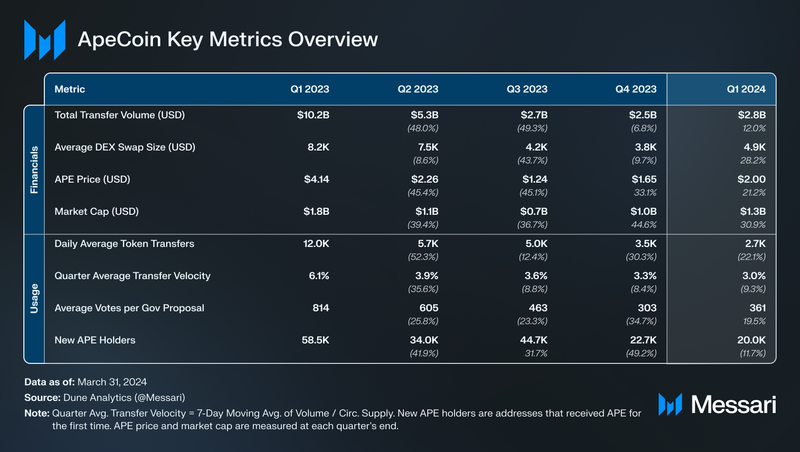
Performance Analysis
Market Cap
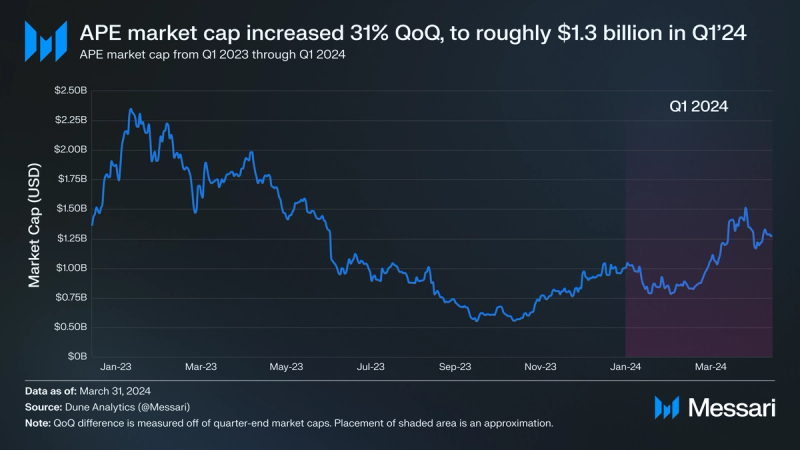
APE’s market capitalization rose 31% QoQ, demonstrating consecutive quarters of growth. By contrast, the general crypto market grew by 53% QoQ, and Bitcoin’s market cap grew by 63% QoQ. Despite dropping below $1 billion in Q2 2023, APE’s market cap recovered its unicorn status, ending Q1 2024 at $1.3 billion. A portion of the market cap increase came from APE’s price rising by 21% QoQ. The remaining increase in market value resulted from the unlock of 46.8 million APE included in the circulating supply. However, this unlock and the $16.5 million committed to governance expenditures may have applied sell pressure to the asset throughout the quarter.
APE Liquid Supply
Liquid supply curves help determine when an increase in sell pressure may occur for certain assets (or when tokens may get dumped onto unsuspecting buyers). Specifically, they show when tokens unlock and to whom.
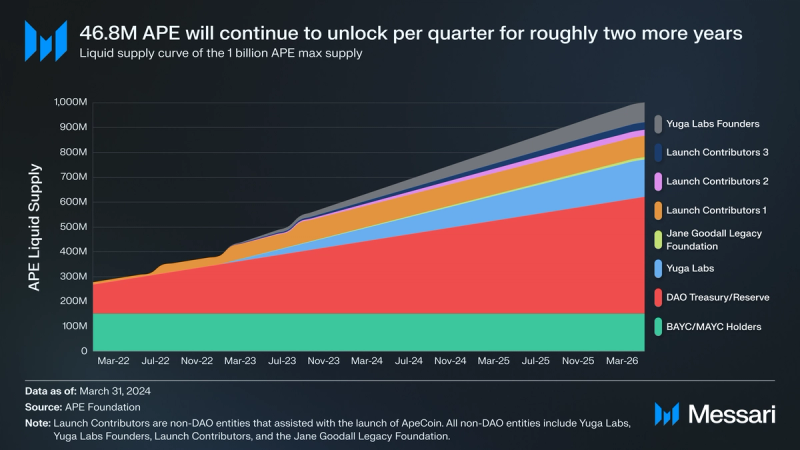
An additional 46.8 million APE (8% of the Q4 circulating supply) was unlocked in Q1 2024. Of this, 22 million APE went to the DAO Treasury, and 24.8 million APE went to non-DAO entities. The DAO then plans to issue or sell APE to fund DAO proposals contingent on them being passed. Alternatively, non-DAO entities are free to sell once their funds are unlocked. In Q1 2024, roughly $16.5 million (8.3 million APE at $2.00/APE) was committed to passed proposals. Despite the sell pressure of an additional 24.8 million APE and a committed 8.3 million APE, the price of APE still increased by 21% QoQ.
Claimed Staking Rewards
ApeCoin DAO started issuing staking rewards in Q4’22 after passing AIP-21 and AIP-22, which finalized staking parameters. APE holders and Yuga Labs’ ecosystem projects like Bored Ape Yacht Club (BAYC), Mutant Ape Yacht Club (MAYC), and Bored Ape Kennel Club (BAKC) received staking allocations.
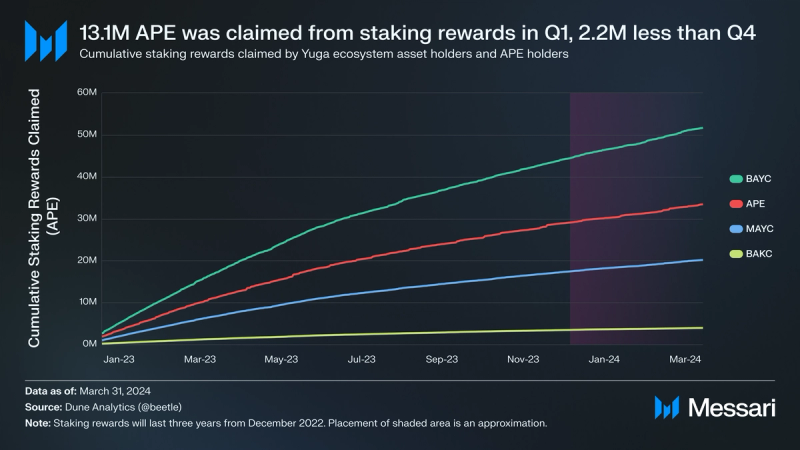
Staking was implemented in early December 2022 and will last for three years. It will ultimately distribute 175 million APE (17.5% of the max supply) to holders of Yuga ecosystem assets and APE tokens. Due to the emissions curve, the amount of APE claimed has decreased every quarter. In Q1, 13.1 million APE was claimed, 14% less than the previous quarter. This trend will continue until December 2025.
Claimed APE compounds the sell pressure from unlocks to non-DAO entities and governance commitments. Along with the APE price rising 21%, transfer volume and the average APE swap size also grew 12% and 28% QoQ, respectively, signaling more trading and peer-to-peer activity with the APE token.
Volume by Trade Size
Volume by trade size shows the percentage of the trading volume corresponding to various trade sizes. For example, if the total volume were $200 million and two wallets traded $50 million each (a total of $100 million), then the two wallets with a volume of $50 million each (a combined $100 million) would account for 50% of the trading volume.
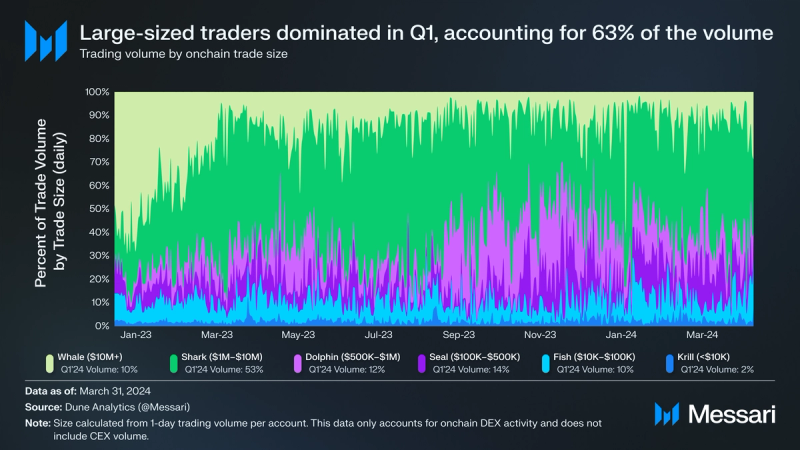
Large-volume traders (accounts with 1-day trading volumes greater than $1 million) were active again in Q1 2024, taking 9% of the trade share from medium-sized traders (greater than $100,000). Whales (greater than $10 million) and sharks (between $1 million and $10 million) accounted for 63% of the trade volume in Q1, with sharks taking 53% alone.
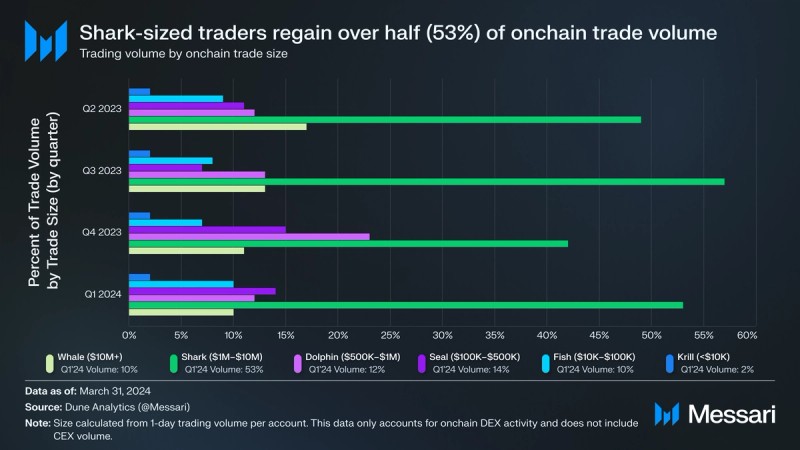
This increase in trade share among larger-volume traders was reflected in the average DEX swap size, which increased by 28% QoQ. Additionally, the 21% increase in the price of APE indicated that a larger volume of buy orders was placed, putting upward pressure on the asset.
The above data only includes onchain activity, not CEX trades. As such, its metrics may not show the full picture, given that higher volume traders may be more inclined to use CEX platforms because they usually offer assurances, protections, and incentives.
Token Velocity
Token velocity shows the frequency through which an asset changes accounts. A change in token velocity can show a few things depending on the asset. If the asset can be used beyond trading, such as a token used within a game, an increase in token velocity may imply that the game encourages the adoption/use of the asset. If the asset is more speculative, a decrease may imply that users are more interested in holding it or that it has low demand. The chart below calculates token velocity by dividing the circulating supply by the seven-day moving average (7DMA) transfer volume.
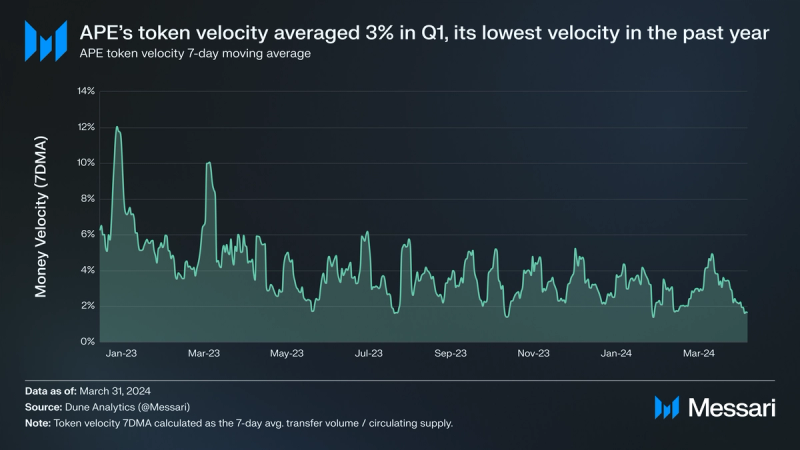
APE’s average transfer velocity fell from 3.3% to 3.0% QoQ. The steady decline throughout the year signals less activity (trading and transfers) among APE holders — though the transfer volume increased by 12% QoQ. The increase may result from larger isolated transfers, such as when value changes hands after the approval of various governance proposals throughout the quarter. Until the pending launch of the Otherside game, which will use APE as an in-game currency, the use cases for APE remained unchanged in Q1.
That said, APE will gain additional utility by implementing two recently passed governance proposals. AIP-381 proposed building game-focused DAOs and vaults only accessible to APE holders. As a result, APE will be able to be used across different ecosystems (like 99starz) for governance and gain access to certain ecosystem assets. The ApeChain proposal selected Horizen Labs to build the previously ideated ApeChain. The blockchain will use APE as a gas token on the network and may support other applications related to the asset. Token velocity may be expected to increase as Otherside and ApeChain launch, given that APE will be used for in-game transfers and gas payments.
New APE Holders

New APE holders are defined as addresses receiving APE for the first time. This metric excludes new holders using centralized exchanges to custody their assets. The inflow of new APE holders decreased by 12% despite the APE price rising by 21%. While APE continued to attract new holders, two consecutive quarters of price increases have not accelerated the growth rate of new APE holders. To attract new holders in the future, ApeCoin DAO formed a branding partnership with a Formula One racing team (approved by the DAO in AIP-406), among other initiatives.
Unique Votes per Proposal
Unique votes per proposal measure how many individuals are participating in governance. If new voters only hold small amounts of an asset, then the impact of their unique votes would be marginal on proposal outcomes in token-weighted governance systems like ApeCoin DAO. However, aggregating unique votes conveys governance interest, diversity of the active holder base, and decentralization of the active holder base.

Although 62% fewer governance proposals were voted on in Q1 2024 compared to the previous quarter, one more proposal was passed (12 compared to 11). ApeCoin DAO committed $16.5 million in funding to those 12 proposals in Q1 2024. Additionally, the average votes per proposal rose by 19% QoQ. This rise in votes per proposal may be due to more impactful proposals making it to the Snapshot process, versus the previous quarter where 60% of the proposals were rejected.
In the future, ApeCoin DAO plans to move more of the voting process onchain. Doing so would remove central points of failure (like the reliance on Snapshot) and add to the governance structure’s decentralization. With ApeChain being built on the Arbitrum technology stack, it will be inexpensive to participate in governance when migrated onchain. Given that the current system is free, the potential bridging and added gas costs may deter some from participating in governance. However, the prospects of a more scalable and useful ecosystem may encourage more holders to participate in guiding the direction of the ecosystem.
Governance Analysis
Throughout Q1 2024, ApeCoin DAO voted on 20 proposals: 12 passed, 7 failed, and 1 was a multiple-choice vote. If the failed AIPs had passed, the implementation costs would have been $3.5 million. The total value of passed proposals and elections was $16.5 million. The one multiple-choice proposal determined which party would be selected to build ApeChain.
The ApeCoin DAO Q4 2023 Transparency Report was published in April. The report shows that the ApeCoin DAO’s holdings could be broken down as follows (using an APE price of $2.00 from Mar. 1, 2024):
- Treasury: 348 million APE ($696 million)
- Owes in Accounts Payable: 464,000 APE ($928,000)
- Reserved for Grants: 76.7 million APE ($153.4 million)
Below are five proposal highlights from the quarter in order from newest to oldest. For a full overview of ApeCoin governance, including preliminary discussions, see Messari’s governance page on ApeCoin.
AIP-406: Formula One Team Partnership
Mar. 20, 2024
In the final proposal of the quarter, AIP-406 outlined a two-year partnership and a third-year renewal option at the DAO’s discretion with an unnamed Formula One (F1) racing team. This partnership is focused on brand exposure. ApeCoin DAO approved $5.6 million to fund this proposal, making it the second-most expensive AIP approved in Q1.
AIP-399: Reserving AIP ID #420
Mar. 20, 2024
AIP-399 proposed temporarily reserving AIP ID #420 for a competition where the winner can use ID #420 and receive a grant of up to 420,000 APE ($840,000 at $2.00/APE). ApeCoin DAO approved this proposal; however, it has yet to determine when this competition will occur and what the exact terms will entail.
Selection of ApeChain Builder
Feb. 14, 2024
Following the approval of a proposal to explore the development of a new blockchain aimed at scaling ecosystem growth (ApeChain), the DAO voted on a subsequent proposal to select a specific entity to construct the chain. The DAO selected Horizen Labs to lead the development of ApeChain using Arbitrum’s technology stack. Offchain Labs (the founding developer of Arbitrum) will also contribute to the project. Neither requested compensation outside revenue generated from participation in ApeChain’s DAC (data availability committee).
AIP-379: Thank APE Funding Phase II
Feb. 1, 2024
Back in January 2023, Thank APE requested up to 40,000 APE to incentivize ad-hoc contributions to the ecosystem via AIP-124. Most recently, Thank APE proposed a one-year initiative seeking 4.2 million APE ($8.4 million at $2.00/APE) to fund value-added projects and contributions to the ApeCoin ecosystem. Thank APE aims to be a trusted third-party capital deployer that can fund projects more efficiently than the DAO. ApeCoin DAO approved AIP-379, making it the most expensive proposal approved in Q1.
AIP-381: GameFi DAOs and Vaults
Feb. 1, 2024
Aiming to expand APE utility further into gaming, AIP-381 proposed building game-focused DAOs and vaults only accessible to APE holders. The 99starz team plans to implement this proposal and allocate 2% of the STZ token supply (2 million STZ) to ApeCoin DAO as a part of the partnership. ApeCoin DAO approved $520,000 to fund this proposal.
Closing Summary
ApeCoin DAO voted for a series of impactful governance proposals. It voted to build ApeChain on the Arbitrum technology stack, expand the utility of the APE token to GameFi DAOs and vaults, and partner with a Formula One team for increased brand exposure. The DAO also saw average votes per proposal increase by 19% and APE velocity drop to 3%, its lowest level throughout the year. On the trading side, APE’s price increased by 21% QoQ, its market cap grew to $1.3 billion (+31% QoQ), and the average DEX swap size rose by 28% QoQ. As ApeCoin DAO continues to approve impactful proposals while its flagship token increases in price, it may attract more participants to contribute to its growing ecosystem.
——











